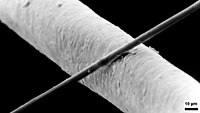
Photo from wikipedia
Current in situ piezoresistive damage detection techniques for fiberglass-reinforced composites are limited in widespread application as they require complex processing techniques which inhibit the scalability of the methods. To eradicate… Click to show full abstract
Current in situ piezoresistive damage detection techniques for fiberglass-reinforced composites are limited in widespread application as they require complex processing techniques which inhibit the scalability of the methods. To eradicate such challenges and expand the use of piezoresistive monitoring of fiberglass composites, this work utilizes a simple, scalable process to coat electrically insulating commercial fiberglass prepreg with piezoresistive laser induced graphene (LIG) for the detection and localization of damage. Recently, LIG has attracted substantial research attention due to the simplicity of the methodology and the piezoresistance of the LIG. Here, the LIG is transfer printed onto commercial fiberglass prepreg which is subsequently used to localize damage in all three dimensions of the resultant fiberglass-reinforced composites while also maintaining the structural properties of the composites. A combination of in situ and ex-situ resistance measurements are used to accomplish this objective: First, in situ measurements are used to determine the relative location of damage in one-dimension under tensile loading. Subsequently, separate in situ measurements are used to locate damage through the thickness under flexural loading. Finally, ex-situ methods are used to calculate the two-dimensional location of a hole in a plate. The LIG is found to reliably and accurately localize the damage to the composite in each case thus demonstrating for the first time that transfer printed LIG enables self-sensing of damage location in fiberglass composites. The result of this work is thus a multifunctional material capable of locating damage in all three-dimensions which is notably fabricated using commercial materials and scalable methodology.
Journal Title: Smart Materials and Structures
Year Published: 2021
Link to full text (if available)
Share on Social Media: Sign Up to like & get
recommendations!